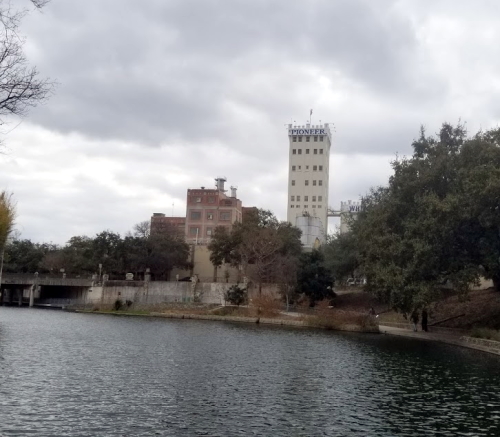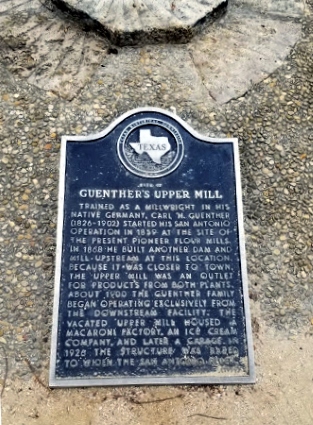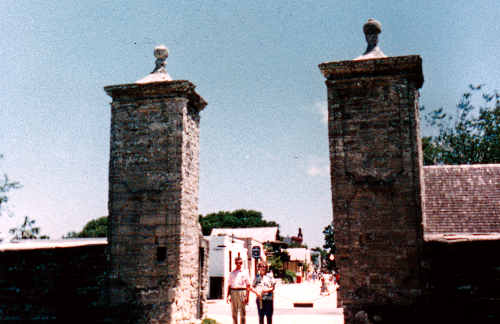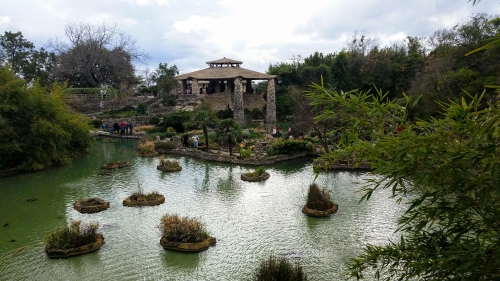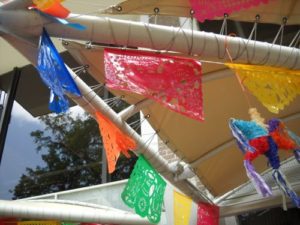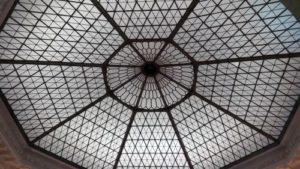I am still in the King William District approaching the Johnson Street Bridge. The pillars on the Johnson Street bridge were originally somewhere else. I’m so embarrassed. I usually know these things off the top my head.
I’ve crossed the Johnson Street Bridge and I took a brief water Pokémon Go (there’s a gym here), and research break and learned that the pillars on the Johnson Street were originally on the original Commerce Street Bridge. The Commerce Street Bridge was moved to Johnson Street. At the very least, the finials are still there. One site (bridgehunter.com) says that this is a new bridge built in the 1980s, but the Austin Chronicle says that the current bridge dates back to the time when O. Henry lived in San Antonio. I may have to go back to the bridge and look for makers’ marks or something to get to the bottom of this.
There are stairs here but I like to take the ramp. Funny, I was walking with Alex one day and I could not remember the word ramp to save my life. I ended up calling it the escalator. I tell people that if I have a stroke nobody will know because I use the wrong words so often.
N.B.: I’m not sure what happened to this next section because I seem to jump back and forth between the next two topics, so I had to try to recreate the paragraphs from what I can recall from the walk.
Just after the Johnson Street Bridge is the headquarters for the San Antonio River System which has some interpretive signage and these cisterns to collect rainwater outside. It also has a nice little half-wall that is a good place to sit down for a while.
Next up is the Pioneer Flour Mill, which was originally the CH Guenther Mill. This is a really pretty building and one of my friends who is very gifted photographer took such a nice picture of it once. I am also taking a picture of it, but it won’t be nearly as good as hers.
I accidentally started a block and now can’t make it go away. So hi there!
So just realized I always had some pictures of how you get from the Riverwalk to the Witte Museum. It’s not as easy as you would think from the signs saying that the Riverwalk goes from Mission Espada in the south to the Witte Museum in the North. The main problem is the Brackenridge Golf Course. The river goes through the golf course, but it’d be too dangerous to have a walking path through it.
So maybe that’s something I could do. I could walk north from the Pearl to the Witte Museum and post my pictures. I’d have to figure out how to make the images work, though. Once upon a time I would have done this with an HTML table with the text in the left column and the pictures in the right column, but I can’t get a table to work in WordPress. I’ll have to wrestle with this idea.
Next door to the Pioneer Flour Mill is a breakfast place called the Guenther House. My mother-in-law took us to breakfast there once and it was really good. I need to go back sometime.
I suspect that a lot of the words I can’t understand might be “doggo.” So many people are walking their dogs on the Riverwalk. Just so many adorable puppers.
I am at the Blue Star Arts Complex and took a break to drink some water and I realized how little water I have. It’s now time to turn around.
Gratuitous Amazon Link time! Today we have Catherine House, by Elisabeth Thomas. Catherine House is a post-secondary school that isn’t a college or university but that fills the same spot. Presumably it qualifies you for, for example, law school, in the same way a university would. The only issue is that while the education only takes three years, students are not allowed to leave campus for that entire three years. Creepy and atmospheric and just so good. At least I enjoyed it. You might, too.

